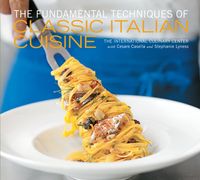Advertisement
Rolling and Filling Shapes for Filled Pasta
Pasta Ripiena: Stendere e Farcire
Appears in
The dough for ravioli and other filled pastas is rolled just as for noodles, with one exception—the dough should be slightly softer and moister so that the layers stick together and the pasta does not crack when shaped and pressed around the filling. Therefore, one piece of dough is rolled through the entire thinning process and then cut and filled before moving onto the next one. To ensure that the two layers of dough adhere well, the dough is brushed with either water or beaten egg.
To maintain a delicate texture, the dough is rolled very thin because it will be overlapped to enclose the filling; if it is rolled too thick, the finished pasta will be dense and heavy around the edges. Once rolled, the dough sheet is placed on a work surface dusted with flour to prevent the dough from sticking.

